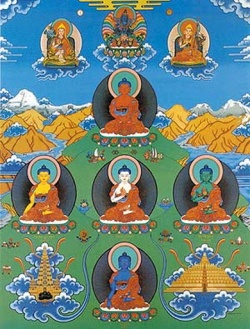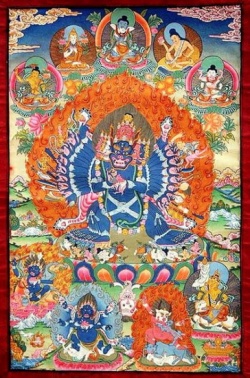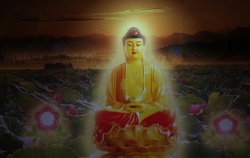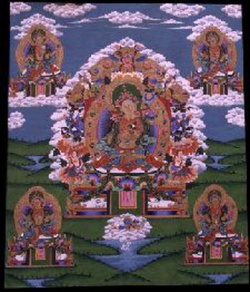Difference between revisions of "The Sūtra On Impermanence"
(Created page with " {{BigTibetan|མི་རྟག་པ་ཉིད་ཀྱི་མདོ།}} The Sūtra on Impermanence Anityatāsūtra; mi rtag pa nyid kyi mdo Toh 3...") |
|||
| (4 intermediate revisions by the same user not shown) | |||
| Line 1: | Line 1: | ||
| + | <nomobile>{{DisplayImages|3173|1583|882|4164|741|147|2483}}</nomobile> | ||
| Line 6: | Line 7: | ||
| − | + | {{BigTibetan|[[མི་རྟག་པ་ཉིད་ཀྱི་མདོ།]]}} | |
| − | {{BigTibetan|མི་རྟག་པ་ཉིད་ཀྱི་མདོ།}} | ||
The [[Sūtra on Impermanence]] | The [[Sūtra on Impermanence]] | ||
| Line 15: | Line 15: | ||
Toh 309, [[Degé]] [[Kangyur]] vol 72 ([[mdo sde]], sa), folios 155a-155b | Toh 309, [[Degé]] [[Kangyur]] vol 72 ([[mdo sde]], sa), folios 155a-155b | ||
| − | Translated by the [[Sakya Pandita Translation Group | + | Translated by the [[Sakya Pandita]] Translation Group (International [[Buddhist]] {{Wiki|Academy}} [[Division]]), under the {{Wiki|patronage}} and supervision of 84000: Translating the [[Words of the Buddha]] |
Summary | Summary | ||
| − | In this brief [[sūtra]], the [[Buddha]] reminds his followers of one of the [[principal]] [[characteristics]] of [[saṃsāric existence]]: the [[reality]] of [[impermanence]]. The four things cherished most in this [[world]], the [[Buddha]] says—namely [[good health]], youth, [[prosperity]], and life—are all [[impermanent]]. He closes his [[teaching]] with a verse, asking how [[beings]], afflicted as they are by [[impermanence]], can take [[delight]] in anything desirable, indirectly urging his [[disciples]] to practice the [[path of liberation]]. | + | In this brief [[sūtra]], the [[Buddha]] reminds his followers of one of the [[principal]] [[characteristics]] of [[saṃsāric existence]]: the [[reality]] of [[impermanence]]. |
| + | |||
| + | The four things cherished most in this [[world]], the [[Buddha]] says—namely [[good health]], youth, [[prosperity]], and life—are all [[impermanent]]. | ||
| + | |||
| + | He closes his [[teaching]] with a verse, asking how [[beings]], afflicted as they are by [[impermanence]], can take [[delight]] in anything desirable, indirectly urging his [[disciples]] to practice the [[path of liberation]]. | ||
| Line 25: | Line 29: | ||
| − | Translation by the | + | Translation by the Sakya Pandita Translation Group (International Buddhist Academy Division, [[Kathmandu]]). This [[sūtra]] was translated from the [[Tibetan]] into English by [[Christian Bernert]] and edited by [[Vivian Paganuzzi]]. |
This translation has been completed under the {{Wiki|patronage}} and supervision of 84000: Translating the [[Words of the Buddha]]. | This translation has been completed under the {{Wiki|patronage}} and supervision of 84000: Translating the [[Words of the Buddha]]. | ||
| Line 33: | Line 37: | ||
| − | This [[sūtra]] highlights one of the most fundamental teachings of the Buddha—recognizing the [[impermanence]] ([[anityatā]]) of [[conditioned phenomena]]. The fact that such [[phenomena]] are [[impermanent]] ([[anitya]]) is listed as the first of the three [[principal]] [[characteristics]] of [[existence]], the other two being the [[suffering]], or {{Wiki|unsatisfactoriness}}, of [[phenomena]] ([[duḥkha]]), and their [[no-self]], or lack of an [[inherent]] [[substance]] ([[anātman]]). It is the [[clear understanding]] of the [[reality]] of these facts of [[life]] that can bring about a profound and [[essential]] change in a person’s worldview, marking the point of entry to the [[path]] to liberation.1 [[Impermanence]] is also one of the “[[four seals]] of the [[Buddha’s teaching]]” (comprising these [[three characteristics of existence]] and a fourth [[principle]], that [[nirvāṇa]] is [[peace]]), often described as summarizing or epitomizing the [[Buddhadharma]], and more particularly as the criteria that together enable the variety of [[Buddhist]] [[philosophical]] [[views]] to be {{Wiki|distinguished}} from [[non-Buddhist]] ones. | + | This [[sūtra]] highlights one of the most fundamental teachings of the Buddha—recognizing the [[impermanence]] ([[anityatā]]) of [[conditioned phenomena]]. |
| + | |||
| + | The fact that such [[phenomena]] are [[impermanent]] ([[anitya]]) is listed as the first of the three [[principal]] [[characteristics]] of [[existence]], the other two being the [[suffering]], or {{Wiki|unsatisfactoriness}}, of [[phenomena]] ([[duḥkha]]), and their [[no-self]], or lack of an [[inherent]] [[substance]] ([[anātman]]). | ||
| + | |||
| + | It is the [[clear understanding]] of the [[reality]] of these facts of [[life]] that can bring about a profound and [[essential]] change in a person’s worldview, marking the point of entry to the [[path]] to liberation.1 | ||
| + | |||
| + | [[Impermanence]] is also one of the “[[four seals]] of the [[Buddha’s teaching]]” (comprising these [[three characteristics of existence]] and a fourth [[principle]], that [[nirvāṇa]] is [[peace]]), often described as summarizing or epitomizing the [[Buddhadharma]], | ||
| + | |||
| + | and more particularly as the criteria that together enable the variety of [[Buddhist]] [[philosophical]] [[views]] to be {{Wiki|distinguished}} from [[non-Buddhist]] ones. | ||
| Line 39: | Line 51: | ||
| − | The [[Tibetan canon]] contains two [[sūtras]] with the title [[Sūtra | + | The [[Tibetan canon]] contains two [[sūtras]] with the title [[Sūtra on Impermanence]] ([[mi rtag pa nyid kyi mdo]]), both found in the same section of the [[Kangyur]] ([[mdo sde]], Toh. 309 and 310). |
| + | |||
| + | The [[sūtra]] translated here is the first, the shorter of the two. [[Sūtras]] with {{Wiki|equivalent}} titles are also found in other [[Buddhist canons]], but their contents differ substantially from the one translated here. | ||
| + | |||
| + | The {{Wiki|Chinese}} [[Tripiṭaka]], for instance, contains two [[sūtras]] so entitled ([[Taishō]] Nos. 801 and 759), and in the [[Samyutta Nikāya]] of the [[Pāli canon]], the [[collection of discourses]] grouped by themes, there are a number of different texts with the title [[Sutta]] on [[Impermanence]] (P. [[Aniccasutta]]). | ||
| Line 45: | Line 61: | ||
| − | The content of this [[sūtra]] is rather straightforward and its [[interpretation]] does not pose any major difficulties. One particular term, however, did {{Wiki|present}} a problem of translation: the [[Tibetan]] dben pa, which commonly translates the [[Sanskrit]] [[viveka]] / [[vivikta]] and is usually related to [[Wikipedia:concept|concepts]] of isolation and [[seclusion]]. Here it seems to refer more specifically to the act of picking something out, separating it from other things and thus singling it out from them as special. | + | The content of this [[sūtra]] is rather straightforward and its [[interpretation]] does not pose any major difficulties. One particular term, however, did {{Wiki|present}} a problem of translation: the [[Tibetan]] [[dben pa]], which commonly translates the [[Sanskrit]] [[viveka]] / [[vivikta]] and is usually related to [[Wikipedia:concept|concepts]] of isolation and [[seclusion]]. |
| + | |||
| + | Here it seems to refer more specifically to the act of picking something out, separating it from other things and thus singling it out from them as special. | ||
| Line 97: | Line 115: | ||
Bibliography | Bibliography | ||
| − | [[mi rtag pa]] [[ | + | [[mi rtag pa nyid kyi mdo]] ([[Anityatāsūtra]]). Toh 309, [[Degé]] [[Kangyur]] vol. 72 ([[mdo sde]], sa), folios 155a.2–155b.4. |
| + | |||
| + | [[mi rtag pa nyid kyi mdo]] ([[Anityatāsūtra]]). [[bka’ ’gyur]] ([[dpe bsdur ma]]) [Comparative Edition of the [[Kangyur]], [[krung go’i bod rig pa zhib ’jug ste gnas kyi bka’ bstan dpe sdur khang]] (The [[Tibetan Tripitaka Collation Bureau of the China Tibetology Research Center]]). [[108]] volumes. | ||
| − | + | {{Wiki|Beijing}}: [[krung go’i bod rig pa dpe skrun khang]] ([[Wikipedia:China Tibetology Research Center|China Tibetology Publishing House]]), 2006–9, vol. 72, 434-436. | |
| − | [[Nyanaponika Thera]] (transl.). [[Anicca Sutta]]: [[Impermanent]] (SN 36.9), translated from the [[Pali]]. Access to | + | [[Nyanaponika Thera]] (transl.). [[Anicca Sutta]]: [[Impermanent]] (SN 36.9), translated from the [[Pali]]. [[Access to Insight]], 30 June 2010, http://www.accesstoinsight.org/tipitaka/sn/sn36/sn36.009.nypo.html . Retrieved on 10 May 2013. |
| − | “[[The Three Basic Facts of Existence]]: I. [[Impermanence]] ([[Anicca]]), with a preface by [[Nyanaponika Thera]],” Access to | + | “[[The Three Basic Facts of Existence]]: I. [[Impermanence]] ([[Anicca]]), with a preface by [[Nyanaponika Thera]],” [[Access to Insight]], 2 December 2011, http://www.accesstoinsight.org/lib/authors/various/wheel186.html . Retrieved on 10 May 2013. |
{{R}} | {{R}} | ||
http://read.84000.co/old-app/#!ReadingRoom/UT22084-072-009/12 | http://read.84000.co/old-app/#!ReadingRoom/UT22084-072-009/12 | ||
[[Category:Sūtra On Impermanence]] | [[Category:Sūtra On Impermanence]] | ||
Latest revision as of 22:35, 16 November 2015
Anityatāsūtra; mi rtag pa nyid kyi mdo
Toh 309, Degé Kangyur vol 72 (mdo sde, sa), folios 155a-155b
Translated by the Sakya Pandita Translation Group (International Buddhist Academy Division), under the patronage and supervision of 84000: Translating the Words of the Buddha
Summary
In this brief sūtra, the Buddha reminds his followers of one of the principal characteristics of saṃsāric existence: the reality of impermanence.
The four things cherished most in this world, the Buddha says—namely good health, youth, prosperity, and life—are all impermanent.
He closes his teaching with a verse, asking how beings, afflicted as they are by impermanence, can take delight in anything desirable, indirectly urging his disciples to practice the path of liberation.
Acknowledgments
Translation by the Sakya Pandita Translation Group (International Buddhist Academy Division, Kathmandu). This sūtra was translated from the Tibetan into English by Christian Bernert and edited by Vivian Paganuzzi.
This translation has been completed under the patronage and supervision of 84000: Translating the Words of the Buddha.
Introduction
This sūtra highlights one of the most fundamental teachings of the Buddha—recognizing the impermanence (anityatā) of conditioned phenomena.
The fact that such phenomena are impermanent (anitya) is listed as the first of the three principal characteristics of existence, the other two being the suffering, or unsatisfactoriness, of phenomena (duḥkha), and their no-self, or lack of an inherent substance (anātman).
It is the clear understanding of the reality of these facts of life that can bring about a profound and essential change in a person’s worldview, marking the point of entry to the path to liberation.1
Impermanence is also one of the “four seals of the Buddha’s teaching” (comprising these three characteristics of existence and a fourth principle, that nirvāṇa is peace), often described as summarizing or epitomizing the Buddhadharma,
and more particularly as the criteria that together enable the variety of Buddhist philosophical views to be distinguished from non-Buddhist ones.
The Tibetan canon contains two sūtras with the title Sūtra on Impermanence (mi rtag pa nyid kyi mdo), both found in the same section of the Kangyur (mdo sde, Toh. 309 and 310).
The sūtra translated here is the first, the shorter of the two. Sūtras with equivalent titles are also found in other Buddhist canons, but their contents differ substantially from the one translated here.
The Chinese Tripiṭaka, for instance, contains two sūtras so entitled (Taishō Nos. 801 and 759), and in the Samyutta Nikāya of the Pāli canon, the collection of discourses grouped by themes, there are a number of different texts with the title Sutta on Impermanence (P. Aniccasutta).
Note on the translation
The content of this sūtra is rather straightforward and its interpretation does not pose any major difficulties. One particular term, however, did present a problem of translation: the Tibetan dben pa, which commonly translates the Sanskrit viveka / vivikta and is usually related to concepts of isolation and seclusion.
Here it seems to refer more specifically to the act of picking something out, separating it from other things and thus singling it out from them as special.
The Sūtra on Impermanence
Homage to all buddhas and bodhisattvas!
Thus did I hear at one time. The Bhagavān was dwelling in Anāthapiṇḍada’s park, in the Jeta Grove in Śrāvastī, along with a large monastic assembly. The Bhagavān addressed the monks as follows:
“Monks, four things are appealing, singled out, considered valuable, pleasant, and highly appreciated by everyone. What are those four?
“Monks, good health is appealing, singled out, considered valuable, pleasant, and highly appreciated by everyone. Good health, however, ends with sickness. Monks, sickness is neither appealing, nor is it singled out, considered valuable, pleasant, or highly appreciated by anyone.
“Monks, youth is appealing, singled out, considered valuable, pleasant, and highly appreciated by everyone. Youth, however, ends with the aging of the body. Monks, the aging of the body is neither appealing, nor is it singled out, considered valuable, pleasant, or highly appreciated by anyone.
“Monks, prosperity is appealing, singled out, considered valuable, pleasant, and highly appreciated by everyone. Prosperity, however, ends with its decline. Monks, the decline of prosperity is neither appealing, nor is it singled out, nor considered valuable, pleasant, or highly appreciated by anyone. [F155.b]
“Monks, life is appealing, singled out, considered valuable, pleasant, and highly appreciated by everyone. Life, however, ends in death. Monks, death is neither appealing, nor is it singled out, considered valuable, pleasant, or highly appreciated by anyone.”
Thus spoke the Bhagavān, the Sugata, and having spoken the Teacher added these words:
“Good health is impermanent,
Youth does not last.
And life, too, does not last.
How can beings, afflicted as they are by impermanence,
Take delight in desirable things like these?”
When the Bhagavān had thus spoken, the monks rejoiced and praised his words.
This completes the Sūtra on Impermanence.
Translated and edited by the Indian scholar Surendrabodhi and the principal editor-translator, the monk Zhang Yeshé Dé. It was then also reviewed and finalized in accordance with current language reforms. Notes
1 See The Three Basic Facts of Existence (The Wheel, Publication no. 186, 187) (details in bibliography).
2 See, for example, The Questions of the Nāga King Sāgara (Toh 155), http://read.84000.co/#!ReadingRoom/UT22084-058-002/0.
3 For instance SN 22.45 and 46, and SN 36.9.
Bibliography
mi rtag pa nyid kyi mdo (Anityatāsūtra). Toh 309, Degé Kangyur vol. 72 (mdo sde, sa), folios 155a.2–155b.4.
mi rtag pa nyid kyi mdo (Anityatāsūtra). bka’ ’gyur (dpe bsdur ma) [Comparative Edition of the Kangyur, krung go’i bod rig pa zhib ’jug ste gnas kyi bka’ bstan dpe sdur khang (The Tibetan Tripitaka Collation Bureau of the China Tibetology Research Center). 108 volumes.
Beijing: krung go’i bod rig pa dpe skrun khang (China Tibetology Publishing House), 2006–9, vol. 72, 434-436.
Nyanaponika Thera (transl.). Anicca Sutta: Impermanent (SN 36.9), translated from the Pali. Access to Insight, 30 June 2010, http://www.accesstoinsight.org/tipitaka/sn/sn36/sn36.009.nypo.html . Retrieved on 10 May 2013.
“The Three Basic Facts of Existence: I. Impermanence (Anicca), with a preface by Nyanaponika Thera,” Access to Insight, 2 December 2011, http://www.accesstoinsight.org/lib/authors/various/wheel186.html . Retrieved on 10 May 2013.
Source
http://read.84000.co/old-app/#!ReadingRoom/UT22084-072-009/12






